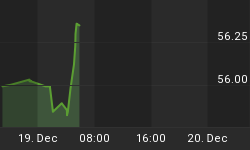So in the end, we got about what I expected from the Fed. Operation Twist was extended, and actually a bit more than I thought they would be able to extend it as the program will continue through year-end.
I said that I would "look for signs that an Evans-type rule is being implemented," and we got a hint of that as well. Remember, the "Evans Rule" is a conditional policy directive modeled after Chicago Fed President Evans' suggestion that the FOMC should provide easy money until unemployment falls below 7% or core inflation rises above 3%. Obviously, the parameters "7%" and "3%" are where the rubber meets the road - without parameterization, the policy reduces to roughly what the Fed said in its statement:
"The Committee is prepared to take further action as appropriate to promote a stronger economic recovery and sustained improvement in labor market conditions in a context of price stability."
Put "an unemployment rate below seven percent" in place of "sustained improvement in labor market conditions" and "core price inflation at or below three percent" in place of "price stability," and you have exactly the Evans Rule. I doubt most of the Committee would accept 3% as an acceptable level for core inflation, but by backing into the Rule in this way the FOMC can argue later about what those parameters actually are.
Bernanke reinforced the point in his after-meeting presser, when he made clear that this didn't mean that stability at 8.2% unemployment would be okay. He said "If we don't see continued improvement in the labor market, we'll be prepared to take additional steps if appropriate." Moreover, the Fed is willing to consider further asset purchases and "still has ammunition." (So you see - they're relevant!)
Since I think the Unemployment Rate is fairly likely to rise, or at least not to fall, from this level, I believe the QE3 crowd got about the best that they could reasonably hope for. There was no sign leading into the meeting that policymakers were thinking seriously about another large-scale asset-purchase (LSAP) program, so it would have been a true shock if one had been delivered. If Greece had already exited the Euro, we probably would have seen it, but otherwise they will take their time to "communicate the strategy clearly" over the next month and a half. That communication will probably not take the form of outright speculation that some more LSAP is needed; with the ball teed up, all speakers need to do is lament the failure of the labor market to do better and the implications are already writ clearly.
It makes sense to go slow here. The economy is weakening, but not plunging. The crisis in Europe is less urgent, for today. The Twist has been extended, so they're not standing idly by, and they've satisfied the importance of appearing relevant and concerned with their statement and promise of great things to come in the future. The ECB two weeks ago didn't ease, and the MPC of the Bank of England narrowly voted against Chairman Mervyn King (in a true democracy, the Chairman sometimes loses), who was seeking to expand the BOE's bond purchase program. The MPC said there was "merit in waiting" to see how things play out in the next few weeks in Europe.
To me, it sounds like July and August will see the next round of QE commence, probably from all major central banks, unless somehow the situation in Europe really does seem to be moving towards an extended period of calm and/or U.S. growth springs forward abruptly. I don't see either of those things happening, but the benefit from waiting is that they might. In the meantime, the only thing the Fed loses is an extra couple of weeks goosing the stock market, but they can get that anyway once the communication strategy commences in earnest.
The data mill churns tomorrow after a couple of days off, with Initial Claims (Consensus: 383k from 386k) tomorrow along with Philly Fed (Consensus: 0.0 from -5.8) and Existing Home Sales (Consensus: 4.57mm from 4.62mm). The Philly Fed number is the most interesting one, as economists are expecting a significant rebound from last month's 14-point decline. I'm not sure why I'd look for a bounce; the NY Purchasing Managers' Index also dropped sharply in May and the Empire Manufacturing figure fell sharply in June. I wouldn't be expecting a big jump from Philly Fed.
















